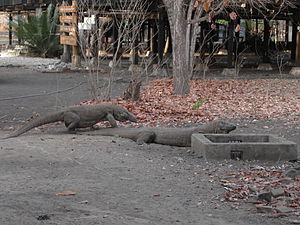Komodo National Park
| UNESCO World Heritage Site | |
|---|---|
 | |
| Criteria | Natural: vii, ix |
| Reference | 609 |
| Inscription | 1991 (15th Session) |
| Komodo National Park | |
|---|---|
| Location | Indonesia |
| Area | 1,735 km² [1], 2,193.22 km² (World Heritage Site) |
| Established | 1980 |
The Komodo National Park is a national park in Indonesia located near the Lesser Sunda Islands in the border region between the provinces of East Nusa Tenggara and West Nusa Tenggara. The park includes the three larger islands Komodo, Rinca and Padar, as well as numerous smaller ones, and a total area of 1817 km² (603 km² of it land). The national park was founded in 1980 in order to protect the Komodo dragon. Later it was dedicated to protecting other species, including marine species. The islands of the national park are of volcanic origin. About 4000 people live within the park. In 1991 the national park was named a UNESCO World Heritage Site.
Scuba diving is popular Komodo National Park because of its high marine biodiversity, including whale sharks, ocean sunfish, manta rays, eagle rays, pygmy seahorse, false pipefish, clown frogfish, nudibranchs, blue-ringed octopus, sponges, tunicates, and coral.
Since 1995, the national park authority has been supported by The Nature Conservancy (TNC), an American environmental organization. A new management plan was co-authored with TNC and implemented in 2000 to address the problem of increasing resource exploitation, both marine and terrestrial. Most pressure on marine resources originates from fishing communities and commercial enterprises from outside the park. However, regulations and restrictions on resource use impact mostly on park residents, who have few options to make a living but rely on what the park has to offer. The provision of alternative livelihoods is part of the overall management strategy, but communities within the park are yet to benefit from appropriate measures addressing their needs (WALHI 2004).
The development of – largely marine-based – ecotourism is the main strategy to make the park self-financing and generate sufficient revenue through entrance fees and tourism licenses to cover operational and managerial costs. To this end, a joint venture between TNC and a tourism operator were granted a tourism concession, that also entails extensive park management rights (PKA & TNC 2000:78). This concession has generated an ongoing controversy. The joint venture has been accused of making decisions behind closed doors, and many people in and around Komodo claim that they haven’t been consulted regarding decisions that ultimately affect their lives WALHI 2003, Dhume, 2000, Jurassic Showdown’, Far Eastern Economic Review, March 16th, pp.50-52).
Most controversy, however, was caused by the death of several fishermen since the 1980s. The circumstances of the fishermen’s deaths are contested. While park patrol (including, at the time, police and navy personnel) claim they acted in self-defense, fishing communities accuse park management of having deliberately killed the fishermen (Down to Earth 2003).
Komodo National Park remains an awe-inspiring experience for tourists and travelers, but the conflict between park management, TNC and local communities continues unabated.
